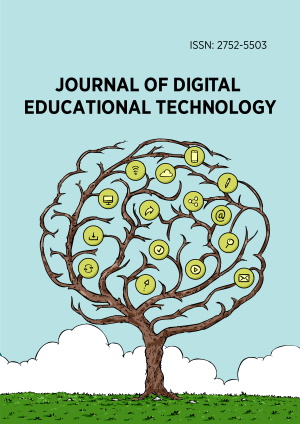Review Article
Mobile Learning Grounded on Universal Instructional Design Principles on the Shift to Emergency Online Education
More Detail
1 College of Teacher Education, Sultan Kudarat State University-ACCESS Campus, Tacurong City, Sultan Kudarat, PHILIPPINES2 College of Education, Mindanao State University, General Santos City, PHILIPPINES* Corresponding Author
Journal of Digital Educational Technology, 1(1), October 2021, ep2102, https://doi.org/10.21601/jdet/10943
Published: 28 May 2021
OPEN ACCESS 3876 Views 2375 Downloads
ABSTRACT
The onset of COVID-19 transmissions enforced school closures worldwide to restrict health threats particularly to students and teachers. Educational responses are developed to pursue the goals of education amid the COVID-19 outbreak. Among these educational responses is the integration of technology in acquiring knowledge through Mobile Learning or M-learning. This article presents the benefits, universal design principles, and strategies of Mobile Learning for the purpose of convenient and accessible learning through the use of mobile phones and ubiquitous technologies. Nonetheless, gaps in curriculum planning, course contents, and technological expertise among instructors need to be addressed to reinforce the implementation of effective Mobile Learning.
CITATION (APA)
Talidong, K. J. B., & Toquero, C. M. D. (2021). Mobile Learning Grounded on Universal Instructional Design Principles on the Shift to Emergency Online Education. Journal of Digital Educational Technology, 1(1), ep2102. https://doi.org/10.21601/jdet/10943
REFERENCES
- Abdulamir, A. S., & Hafidh, R. R. (2020, March 21). The possible immunological pathways for the variable immunopathogenesis of COVID—19 infections among healthy adults, elderly and children. Electronic Journal of General Medicine, 17(4), em202. https://doi.org/10.29333/ejgm/7850
- Baker, A., Dede, C., & Evans, J. (2014). The 8 essentials for mobile learning success in education. Qualcomm. https://www.qualcomm.com/media/documents/files/the-8-essentials-for-mobilelearning-success-in-education.pdf
- Bao, W. (2020). COVID-19 and online teaching in higher education: A case study of Peking University. Human Behavior and Emerging Technologies, 2, 113-115. https://onlinelibrary.wiley.com/doi/pdf/10.1002/hbe2.191
- Bates, T. (2020, March 9). Advice to those about to teach online because of the corona-virus. Online Learning and Distance Education Resources. https://www.tonybates.ca/2020/03/09/advice-to-those-about-to-teach-online-becauseof-the-corona-virus/
- Bender, L. (2020). Key Messages and Actions for COVID-19 Prevention and Control in Schools. UNICEF. https://www.unicef.org/romania/documents/key-messages-and-actions-covid-19prevention-and-control-schools
- Beutner, M., & Rüscher, F. A. (2017). Acceptance of mobile learning at SMES of the service sector. 13th International Conference Mobile Learning (pp. 63-70). IADIS Press. https://files.eric.ed.gov/fulltext/ED579190.pdf
- Camilleri, M. A., & Camilleri, A. C. (2019). The acceptance and use of mobile learning applications in higher education. In A. Pfennig, & Chen, K.C. (Eds.), 3rd International Conference on Education and eLearning (ICEEL2019) (pp. 1-6), Barcelona. https://doi.org/10.1145/3371647.3372205
- Cheon, J., Lee, S., Crooks, S. M., & Song, J. (2012, November). An investigation of mobile learning readiness in higher education based on the theory of planned behavior. Computers & Education, 59(3), 1054-1064. https://doi.org/10.1016/j.compedu.2012.04.015
- Elias, T. (2011, February). Universal instructional design principles for mobile learning. International Review of Research in Open and Distance Learning, 12(2), 143-156. https://doi.org/10.19173/irrodl.v12i2.965
- Geddes, S. (2004). Mobile learning in the 21st century: Benefit for learners. http://hdl.voced.edu.au/10707/383787
- Gondauri, D., Mikautadze, E., & Batiashvili, M. (2020). Research on COVID-19 virus spreading statistics based on the examples of the cases from different countries. Electronic Journal of General Medicine 17(4) em209. https://doi.org/10.29333/ejgm/7869
- Hashemia, M., Azizinezhad, M., Najafia, V., & Nesari, A. J. (2011). What is Mobile Learning? Challenges and Capabilities. Procedia - Social and Behavioral Sciences, 2477-2481. https://doi.org/10.1016/j.sbspro.2011.10.483
- Hodges, C., Moore, S., Lockee, B., Trust, T., & Bond, A. (2020, March 27). The difference between emergency remote teaching and online learning. Educause Review. https://er.educause.edu/articles/2020/3/the-difference-between-emergency-remote-teaching-and-online-learning
- Holotescu, C., & Grosseck, G. (2011). Mobile learning through microblogging. Procedia Social and Behavioral Sciences, 15, 4-8. https://doi.org/10.1016/j.sbspro.2011.03.039
- Ismail, I., Johari, S. S., & Idrus, R. M. (2010). Acceptance on mobile learning via SMS: A rasch model analysis. International Journal of Interactive Mobile Technologies, 4(2), 10-16. https://doi.org/10.3991/ijim.v4i2.1144
- Jenkins, J. (2016, July 5). 6 mobile learning benefits: The mobile learning revolution. https://elearningindustry.com/6-mobile-learning-benefits-mobile-learning-revolution
- LaBonte, R. (2020, March 30). Emergency remote teaching: Resources, tools, and ideas. https://canelearn.net/emergency-remote-teaching/
- Li, C., & Lalani, F. (2020, April 29). The COVID-19 pandemic has changed education forever. This is how. World Economic Forum. https://www.weforum.org/agenda/2020/04/coronavirus-education-global-covid19-online-digital-learning/
- Marpadga, A. (2020, January 23). Benefits and limitations of mobile learning. https://blog.commlabindia.com/elearning-development/mlearning-benefits-limitations
- Mehdipour, Y., & Zerehkafi, H. (2013). Mobile learning for education: Benefits and challenges. International Journal of Computational Engineering Research, 3(6), 93101. http://www.ijceronline.com/papers/Vol3_issue6/part%203/P03630930100.pdf
- Meng, L., Hua, F., & Bian, Z. (2020). Coronavirus disease 2019 (COVID-19): Emerging and future challenges for dental and oral medicine. Journal of Dental Research, 481487. https://doi.org/10.1177/0022034520914246
- Palvia, S., Aeron, P., Gupta, P., Mahapatra, D., Parida, R., Rosner, R., & Sindhi, S. (2018). Online Education: Worldwide Status, Challenges, Trends, and Implications. Journal of Global Information Technology Management, 21(4), 233-241. https://doi.org/10.1080/1097198X.2018.1542262
- Pan, H. (2020). A glimpse of university students’ family life amidst the COVID-19 virus. Journal of Loss and Trauma, 25(6-7), 594-597. https://doi.org/10.1080/15325024.2020.1750194
- Quevillon, K. (2018, January 31). Online teaching: 4 unique challenges and how to solve them. Top Hat Blog. https://tophat.com/blog/online-teachingchallenges/
- Talidong, K. J., & Toquero, C. M. (2020). Philippine Teachers’ Practices to Deal with Anxiety amid COVID-19. Journal of Loss and Trauma, 25(6-7), 573-579. https://doi.org/10.1080/15325024.2020.1759225
- Toquero, C. M. D., Calago, P. A., & Pormento, S. B. (2021). Neoliberalism crisis and the pitfalls and glories in emergency remote education. Asian Journal of Distance Education, 16(1), 90-97. https://doi.org/10.5281/zenodo.4672777
- Traxler, J. (2009). Learning in a mobile age. IJMBL, 1(1), 1-12. http://doi.org/10.4018/jmbl.2009010101
- Yuen, S. C., & Yuen, P. K. (2008). Mobile learning. In L. A. Tomei (Ed.), Encyclopedia of information technology curriculum integration. Idea Group.

 The articles published in this journal are licensed under the CC-BY Creative Commons Attribution International License.
The articles published in this journal are licensed under the CC-BY Creative Commons Attribution International License.